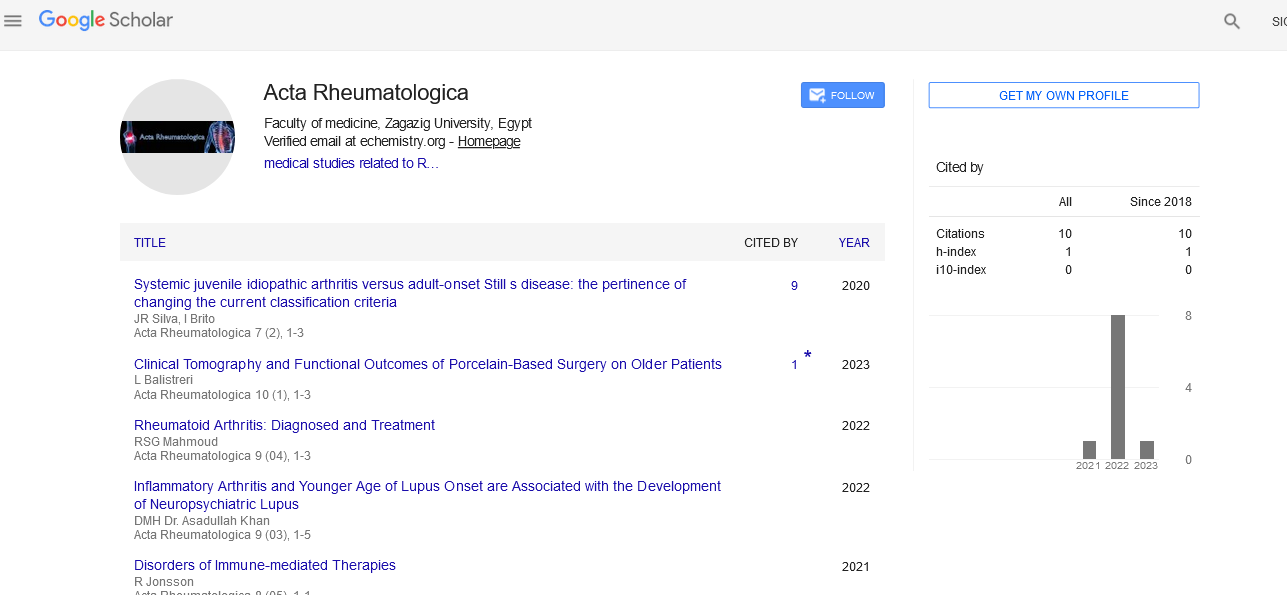Perspective - (2024) Volume 11, Issue 6
Rheumatic Manifestations in Chronic Hepatitis C Virus Infection
Nimisha Patel*
Department of Health Care, Guntur Medical College, Guntur, India
*Correspondence:
Nimisha Patel, Department of Health Care, Guntur Medical College, Guntur,
India,
Email:
Received: 15-Nov-2024, Manuscript No. IPAR-24-15244;
Editor assigned: 19-Nov-2024, Pre QC No. IPAR-24-15244 (PQ);
Reviewed: 03-Dec-2024, QC No. IPAR-24-15244;
Revised: 13-Dec-2024, Manuscript No. IPAR-24-15244 (R);
Published:
20-Dec-2024
Introduction
Chronic Hepatitis C Virus (HCV) infection is primarily recognized
for its impact on liver health, potentially leading to cirrhosis and
hepatocellular carcinoma. However, the systemic nature of HCV
can also manifest through various extrahepatic complications,
including rheumatic symptoms. Understanding these rheumatic
manifestations is essential for clinicians to provide comprehensive
care for patients with chronic HCV infection. This article explores
the relationship between HCV and rheumatic diseases, focusing
on the mechanisms, common manifestations, diagnostic
approaches, and management strategies.
Description
Overview of hepatitis C virus infection
HCV is an RNA virus that primarily spreads through blood-toblood
contact. It often results in a chronic infection, affecting an
estimated 71 million people globally. The chronic phase of HCV
can lead to significant morbidity due to its effects not only on
the liver but also on other organ systems, including the
musculoskeletal system.
Mechanisms of HCV-induced rheumatic symptoms
The exact mechanisms through which HCV induces rheumatic
manifestations are multifaceted and not entirely understood.
Several factors contribute to the development of rheumatic
symptoms in patients with chronic HCV infection:
Immune response: HCV can trigger a dysregulated immune
response characterized by increased production of autoantibodies.
This autoimmune aspect may lead to the development of various
rheumatic conditions.
Cytokine dysregulation: Chronic HCV infection can lead to
elevated levels of pro-inflammatory cytokines such as Tumor
Necrosis Factor-Alpha (TNF-α) and Interleukin-6 (IL-6). These
cytokines play significant roles in inflammation and pain,
contributing to musculoskeletal symptoms.
Direct viral effects: There is evidence that HCV can directly
infect extrahepatic tissues, including joints and connective
tissues, leading to inflammation and pain.
Genetic predisposition: Certain genetic factors may make
individuals more susceptible to developing rheumatic
manifestations in the context of HCV infection.
Common rheumatic manifestations
Arthralgia and arthritis: One of the most prevalent rheumatic
manifestations in chronic HCV infection is arthralgia, or joint
pain. Patients often report diffuse pain that may mimic
conditions such as Rheumatoid Arthritis (RA). While HCV-related
arthritis typically does not lead to significant joint destruction, it
can significantly impact a patient's quality of life.
Sjogren’s syndrome: Sjogren’s syndrome is an autoimmune
disorder characterized by dry eyes and mouth, and it has been
associated with chronic HCV infection. Patients may experience
dry mucous membranes, fatigue, and joint pain. This condition
often complicates the clinical picture, as its symptoms can
overlap with other rheumatic diseases.
Fibromyalgia: Fibromyalgia is characterized by widespread
musculoskeletal pain, fatigue, and cognitive disturbances. It has
been observed in patients with chronic HCV infection, possibly
due to the chronic inflammatory state induced by the virus.
Fibromyalgia can further complicate the management of HCV
due to its multifaceted symptoms.
Vasculitis: Although less common, vasculitis has been
reported in some patients with chronic HCV. This inflammation
of blood vessels can lead to a range of symptoms, including skin
rashes, peripheral neuropathy, and muscle pain. The association
between HCV and vasculitis underscores the need for careful
monitoring of systemic symptoms in affected individuals.
Diagnosis of rheumatic manifestations
Diagnosing rheumatic manifestations in the context of chronic
HCV infection requires a comprehensive approach that includes:
Clinical assessment: A thorough patient history and physical
examination are critical. Clinicians should inquire about joint
pain, fatigue, skin changes, and other systemic symptoms.
Laboratory tests: Routine blood tests can help identify
markers of inflammation, liver function tests, and the presence
of autoantibodies. Elevated levels of Rheumatoid Factor (RF) and
Anti-Nuclear Antibodies (ANA) may suggest autoimmune
activity.
Imaging studies: Joint imaging, such as ultrasound or MRI, can
be useful in assessing the presence of inflammation or damage
in the joints.
HCV testing: Confirming the presence of HCV through
serological testing (anti-HCV antibodies) and PCR testing (HCV
RNA) is essential to establish the link between rheumatic
symptoms and the viral infection.
Management strategies
Managing rheumatic manifestations in patients with chronic
HCV infection requires a multidisciplinary approach:
Antiviral treatment: Successful treatment of HCV with Direct-
Acting Antivirals (DAAs) can lead to resolution of rheumatic
symptoms in some patients. Studies have shown that
eradicating the virus can improve arthralgia and other systemic
symptoms, underscoring the importance of addressing the
underlying infection.
Symptomatic relief: Patients experiencing joint pain or
inflammation may benefit from Non-Steroidal Anti-Inflammatory
Drugs (NSAIDs) to manage symptoms. Corticosteroids may be
considered for more severe inflammatory conditions, although
caution is necessary due to potential effects on liver health.
Management of autoimmune symptoms: For patients with
conditions like Sjögren’s syndrome or fibromyalgia, symptoms pecific treatments should be implemented. This may include
the use of medications like hydroxychloroquine for Sjögren’s or
pharmacologic and non-pharmacologic interventions for
fibromyalgia.
Regular monitoring: Continuous monitoring of both liver
function and rheumatic symptoms is essential in managing
patients with chronic HCV. Regular follow-up can help identify
any new developments and allow for timely interventions.
Conclusion
Chronic Hepatitis C virus infection has significant implications
beyond liver disease, with various rheumatic manifestations
impacting patient quality of life. Recognizing the relationship
between HCV and these extrahepatic complications is crucial for
clinicians in providing holistic care. A multidisciplinary approach
that includes antiviral treatment, symptomatic relief, and regular
monitoring can help manage the complexities associated with
HCV-related rheumatic symptoms. As research continues to
evolve, further insights into the pathophysiology and optimal
management strategies will enhance the care of patients living
with chronic hepatitis C and its rheumatic manifestations.
Citation: Patel N (2024) Rheumatic Manifestations in Chronic Hepatitis C Virus Infection. Acta Rheuma Vol:11 No:6





